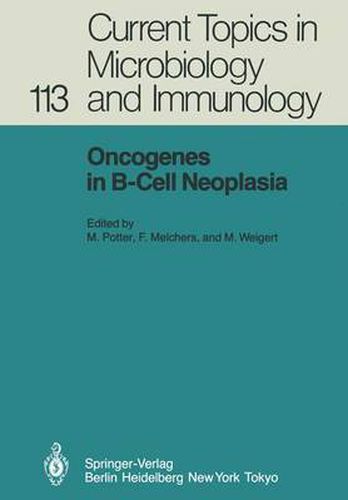Readings Newsletter
Become a Readings Member to make your shopping experience even easier.
Sign in or sign up for free!
You’re not far away from qualifying for FREE standard shipping within Australia
You’ve qualified for FREE standard shipping within Australia
The cart is loading…






This title is printed to order. This book may have been self-published. If so, we cannot guarantee the quality of the content. In the main most books will have gone through the editing process however some may not. We therefore suggest that you be aware of this before ordering this book. If in doubt check either the author or publisher’s details as we are unable to accept any returns unless they are faulty. Please contact us if you have any questions.
Michael Potter, Fritz Melchers, Martin Weigert The second workshop on Mechanisms of B Cell Neoplasia was held in Bethesda, Maryland in Wilson Hall at the National Institutes of Health on March 5, 6, and 7, 1984. It followed a workshop on the same topic that was held at the Basel Institute for Immunology, March 15-17, 1983. That first meeting attempted to bring together cell biologists, experimental pathologists and molecular geneti- cists interested in B cells, to discuss pathogenetic processes in the development and maintenance of the neoplastic state. The impetus for this discussion emanated from two important developments: first, the discovery of the viral promoter insertion mechanism for acti- vating the myc oncogene in bursal lymphomatosis by Hayward, Neil, and Astrin;-second, the findings that the non-random chromosomal trans locations involving the immunoglobulin gene chromosomes occur- red in very high frequencies in murine plasmacytomas and human Burkitt’s lymphomas. During the planning stages of that meeting Shen-Ong et al. discovered that non-random translocations activated the myc oncogene. Promoter insertions and non-random trans locations were-rwo mechanisms that caused transcription of the myc oncogene messages in three different kinds of well defined experimental and clinical B cell tumors. Unregulated myc gene transcription provided the first evidence of a specific bioChemical lesion in B cell neo- plasia.
$9.00 standard shipping within Australia
FREE standard shipping within Australia for orders over $100.00
Express & International shipping calculated at checkout
This title is printed to order. This book may have been self-published. If so, we cannot guarantee the quality of the content. In the main most books will have gone through the editing process however some may not. We therefore suggest that you be aware of this before ordering this book. If in doubt check either the author or publisher’s details as we are unable to accept any returns unless they are faulty. Please contact us if you have any questions.
Michael Potter, Fritz Melchers, Martin Weigert The second workshop on Mechanisms of B Cell Neoplasia was held in Bethesda, Maryland in Wilson Hall at the National Institutes of Health on March 5, 6, and 7, 1984. It followed a workshop on the same topic that was held at the Basel Institute for Immunology, March 15-17, 1983. That first meeting attempted to bring together cell biologists, experimental pathologists and molecular geneti- cists interested in B cells, to discuss pathogenetic processes in the development and maintenance of the neoplastic state. The impetus for this discussion emanated from two important developments: first, the discovery of the viral promoter insertion mechanism for acti- vating the myc oncogene in bursal lymphomatosis by Hayward, Neil, and Astrin;-second, the findings that the non-random chromosomal trans locations involving the immunoglobulin gene chromosomes occur- red in very high frequencies in murine plasmacytomas and human Burkitt’s lymphomas. During the planning stages of that meeting Shen-Ong et al. discovered that non-random translocations activated the myc oncogene. Promoter insertions and non-random trans locations were-rwo mechanisms that caused transcription of the myc oncogene messages in three different kinds of well defined experimental and clinical B cell tumors. Unregulated myc gene transcription provided the first evidence of a specific bioChemical lesion in B cell neo- plasia.